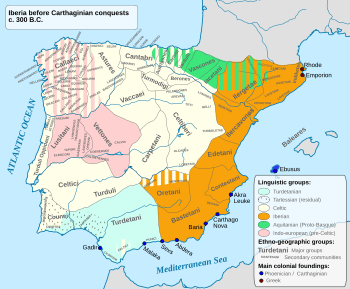Carpetani facts for kids
The Carpetani were an ancient group of people. They lived in the central part of the Iberian Peninsula. This area is now Spain and Portugal. They were similar to the Celtiberians. The Carpetani lived before the Romans took over.
Contents
Where Did the Carpetani Live?
The Carpetani lived in central Spain. They settled there around 500 BC. Their land stretched from the Guadarrama River in the north. It went down to the upper Guadiana River in the south. This area is now parts of Guadalajara, Toledo, Madrid, and Ciudad Real. Ancient writers called this region Carpetania.
Carpetani Cities
The Carpetani had several important cities. These were like small city-states.
- Toletum was near modern Toledo. It was a very important center.
- Iplacea or Complutum was near Alcalá de Henares.
- Titulcia was near the modern town of Titulcia.
- Consabura was near Consuegra.
- Barnacis was near Orgaz.
- Alce was near Campo de Criptana.
Some of these cities even made their own coins.
Where Did the Carpetani Come From?
The exact origins of the Carpetani are not fully known. Their leaders likely came from Celtiberian and Gallic groups. These groups arrived in the Iberian Peninsula around 400 BC. The rest of the people were a mix of different ancient groups.
Carpetani Tribes
The Carpetani were made up of many different tribes. There were about twenty-seven tribes in total. Some of these tribes included:
- The Aelariques
- The Arquioci
- The Bocouriques
- The Contucianci
- The Langioci
- The Mesici
- The Solici
What Was Carpetanian Culture Like?
Archaeologists believe the Carpetani culture grew from earlier groups. These groups were farmers from the late Bronze Age and early Iron Age.
Carpetani Coins
Not many Carpetanian towns made their own money. The coins they did make looked like Roman coins. Or they copied Celtiberian coins.
- Around 200 BC, Iplacea/Complutum and Barnacis made coins. Their names were written in Celtiberian script.
- Later, Toletum made coins with its name in Latin script.
History of the Carpetani
By the late 200s BC, the Carpetani had formed a loose group of tribes. Their main center was Toletum. Different towns were ruled by small kings.
Battles and Treaties
- In 193 BC, a Carpetanian king named Hilernus led a group of tribes. They fought against the Roman leader Marcus Fulvius near Toletum. But Hilernus was defeated and captured.
- In 179 BC, another king named Thurrus from Alce signed a peace agreement. He made this treaty with the Roman leader Tiberius Sempronius Gracchus.
Fighting Carthage
Before the Second Punic War, the Carpetani tried to stop Hannibal from expanding his power. Hannibal was a famous general from Carthage. In 220 BC, Hannibal defeated the Carpetani and their allies. This happened at the Battle on the Tagus River. After this, Hannibal controlled most of southern Spain.
The Carpetani also sometimes fought as paid soldiers for Carthage. Some 3,000 Carpetanian warriors even left Hannibal's army. This happened when he entered Italy after crossing the Alps.
Loyalty to Rome
During the Sertorian Wars, the Carpetani stayed loyal to Rome. Their rivals, the Vettones and Celtiberians, sided with Rome's enemy, Quintus Sertorius.
From 197 BC onwards, Rome slowly took control of Hispania. This was a long process. It involved trade, diplomacy, and sometimes military action. The Romans turned some native cities into cities that paid taxes. They also built new Roman towns to expand their control.
See also
 In Spanish: Carpetanos para niños
In Spanish: Carpetanos para niños
- Carpetania
- Celtiberians
- Celtiberian script
- Vettones
- Pre-Roman peoples of the Iberian Peninsula


